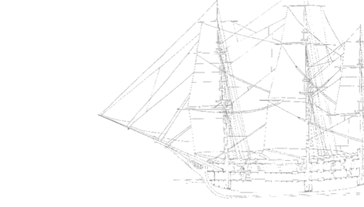|
The Museum at Work: Dirk Hartog Island
2006
The north end of Dirk Hartog Island is one of two maritime sites
in Western Australia placed on the National Heritage List by the
Commonwealth Government. This place has national significance due
to the number of explorers and scientific expeditions that have
been drawn to the Island and have left behind relics of these journeys.
| The Western Australian Museum had
spent over thirty years undertaking fieldwork on Dirk Hartog
Island and Shark Bay. In 2006 the Museum’s maritime archaeologists
received a grant under the Federal Government’s Gift
to the Nation Scheme to make an archaeological survey and
excavation of the area. Led by Jeremy Green, a group of Museum
staff, contract specialists and volunteers undertook an intensive
three week survey and excavation of the area.
This dig did not find any new evidence, however. The team
concluded that the first coin and cap were not found in their
original location and could have been discarded by a fossicker.
The bottle that contained the annexation document seemed
long gone. In contrast, the evidence showed that the bottle
found in April 1998 by the Museum had not been disturbed
and lay where it had been buried by the French explorers.
St
Alouran's Bottle
On 29 March 1772 the Gros
Ventre commanded
by Louis de Saint Aloüarn anchored off Turtle Bay at
the north end of Dirk Hartog Island. |

Above: Expedition artefact manager Richenda
Prall records finds, while other museum staff, contract archaeologists
and volunteers excavate the annexation site.
|
Next
morning, Saint Aloürarn sent a boat with an officer, boat
crew and five soldiers to reconnoitre the land. They walked inland
for over 14 kilometres, finding no one. Returning to the coast
they took possession of the land. A flag was raised, a prepared
document read aloud followed by cries of “Long live the
King” and
a volley of musket shots.

Above: The Gros Ventre at Port Louis, Mauritius,
where she ended her career. Watercolour by Frédéric
Roux (1828).
|
The document was put in a bottle and buried at
the foot of a small tree. Two coins, or écus,
of six francs each were placed nearby. The ship’s log
refers to the bay as ‘Baie de Prise de Possession’.
After the coin was found at Turtle Bay in 1998, the Museum
sent an expedition to search for the bottle.
On 1 April 1998
Bob Sheppard, Bob Creasy and Dr Michael McCarthy discovered
an intact bottle with a lead seal similar that found by
the French team in January.
|
The bottle was carefully
excavated by archaeologist Rodney Harrison. The flower pot
shape of the bottle showed that it had probably been made in France
in the mid 18th century. However the bottle appeared not to
contain the annexation document.
Conservation Treatment
Non-invasive investigations
To determine if there was a document in the bottle, a series of
CT Scans (Computer Tomography) were taken by the Department of
medical Imaging at Royal Perth Hospital. Dark shadows in the sand
indicated the presence of organic material which could have been
paper or parchment. A cork in the neck of the bottle was also identified.
Removal of the lead closure
The iron wire securing the lead closure had to be removed
before the contents of the bottle could be examined.
The microscope revealed several small fractures which
allowed segments of the wire to be carefully detached.
The
brittleness of the lead meant it had to be gently warmed
to make it more malleable. A fragment of lead sheathing
from Cook’s Endeavour and a hair dryer
was used to test the amount of heat required. This method was
then applied to the bottle closure. Conservators gently prised
open two of the warmed ‘lugs’ and easily lifted
the closure free.
Right: Lead closure with silver écu
dated 1767. Red deposits on the cork, coin and rim of bottle
contained cinnabar. |
|
Popping the cork
The cork was firmly fixed inside the neck of the bottle. Sand around
the cork’s edges was gently removed with fine dental instruments
to create enough space for a thin brass shim to pass between
the cork and the glass. The cork could now be carefully pulled
from the bottle.
Deposits of red material on the top of the cork,
rim of the bottle and surface of the coin indicated that the
coin had been originally sealed with wax. Samples were sent
for analysis and found to contain cinnabar, a red pigment used
to colour wax. Possibly the seal was eaten by insects entering
the gaps in the lead enclosure. The inner end of the cork had clearly
been attacked by insects.

Above: Dr Simon Turner
and museum curator Myra Stanbury examining the contents of
the bottle
|
Investigating the bottle contents
To examine the inside of the bottle conservators called in Dr Simon Turner and
Chris Papadopolus Stryker Division of Stubber Medical Pty Ltd. Using a fine
cystoscope connected to a digital camera and computer, Dr Turner was able to
examine the contents of the bottle.
There was no evidence of paper or parchment, only sand was
found inside. Microscopic examination of the sand
revealed remnants of plant material, pollen grains, spores and
chitins (insect parts). |
What happened to the annexation document
remains a mystery.
French Coin
In January 1998, a team led by French
historian M. Philippe Godard, including Geraldton residents Max
Cramer, Kim Cramer, John Eckersley, Tom Brady and Chris Shine,
discovered a French écu of 1766
with the bust of King Louis XV at a site on the cliff top overlooking
Turtle Bay, at the north end of Dirk Hartog Island.
The silver coin was encased in a lead capsule, possibly a seal
taken from a bale of cloth. The bottle and the annexation document
were not found.
The significance of the discovery prompted the Western
Australian Museum to send an expedition to the site in March
1998.
Click here to go to the previous page. |













